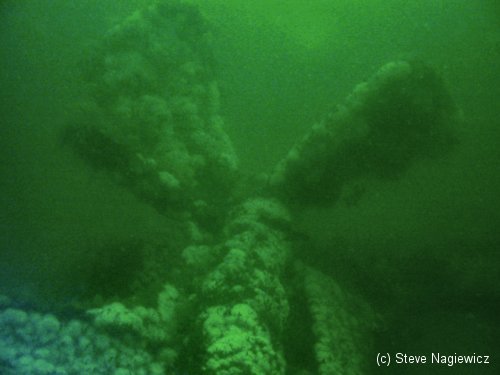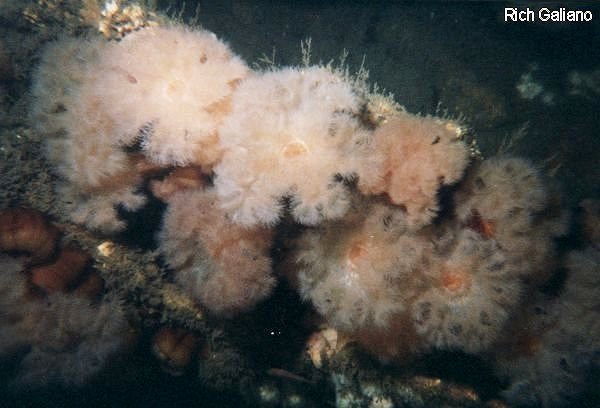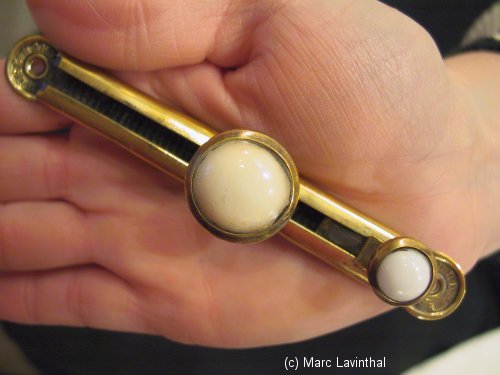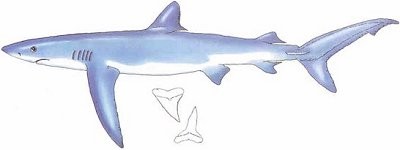Brunette

- Type:
- shipwreck, steamer, USA
- Built:
- 1867, Pusey & Jones, Wilmington DE USA
- Specs:
- 274 tons (?), 9 crew
- Sunk:
- Tuesday February 1, 1870
collision with steamer Santiago de Cuba ( 1627 tons) - 2 casualties - Depth:
- 75 ft

The wreck of the Brunette bears a striking resemblance to the Delaware. The form of a ship is clearly evident (although not in the picture below), from the chain locker at the bow to the propeller at the stern. One difference is that while the Delaware was wood, the Brunette was iron, so instead of ribs, the wreckage is outlined by rusted metal hull plates protruding slightly from the sand. Another difference is that the Delaware lies in mud, while the Brunette lies in clean sand. So I guess they're not all that alike after all.
Overall, this wreck seems smaller than the Delaware. The tonnage quoted above is almost certainly the cargo capacity, not the gross tonnage. In any case, the Brunette was a very small steamer for her time and sank in only ten minutes after her port side was smashed in by the much larger Santiago de Cuba.
The highest part of the wreck is the large steam engine, which stands crooked amidships, perhaps 10 ft tall. From there the drive shaft extends back to the four-bladed iron propeller, which is over six feet in diameter. The stern has collapsed and flattened, and from beneath one of the hull plates, I once took a four-pound lobster. The boilers in front of the engine are a good place for spearfishing.
The Brunette is known as a good digging wreck, having produced many fine artifacts when it was initially discovered. Capt. Steve adds: "We have recovered school bells, horse spurs, keys, doorjambs and of course the doorknobs, gunpowder flasks, small pocket knives, brass buttons, pewter forks, spoons, Missaquois Soda bottles, and assorted hardware ( we used to refer to it as the "Rickel Wreck" for all the hardware we found ... alas now we'd be forced to call it the 'Home Depot Wreck'. )"
Brunette
The Brunette was a 274-ton screw propeller freighter, built in 1867 by Pusey & Jones Yards, Wilmington, Delaware. On February 1, 1870, the Brunette was en route from New York to Philadelphia with a general cargo. At 10:00 PM she collided with the Santiago de Cuba.
According to the Philadelphia Inquirer "On Tuesday afternoon at 6 pm the steamer Brunette, Capt Doane, left the Lorillard Steamship Dock, bound to Philadelphia. She was laden with an assorted cargo, and about three-quarters full. Including officers, there were thirteen souls on board. Nothing of interest occurred until about 20 minutes past 10, when a steamer was noticed bearing down for the Brunette. She proved to be the Santiago de Cuba. It seems that the Brunette attempted to cross the bow of the Santiago de Cuba and failing to do so in time, the two vessels collided. Every effort was made onboard both vessels to avoid the disaster by reversing the engines, but the orders were given too late, and the Santiago de Cuba struck the Brunette a terrific blow in the port broadside, completely crushing her in and keeling her over to starboard." Two of the Brunette's crew perished in the accident.

Captain George Hoffman found this wreck a few years back. When divers started to dig, they recovered crates of brown and white marble door knobs, pocket knives, and bottles. All that is left of her is her propeller shaft, coal-fired steam engine, and boilers. The "Door Knob Wreck", as she is more commonly known, rests 200 feet away from the Cadet in 70 feet of water. The Brunette is one of New Jersey's best artifact wrecks.
Excerpted from Wreck Valley CDROM by Dan Berg



video courtesy of Dan Crowell
Our tour begins at the propeller, and goes forward along the shaft to the crooked engine. Forward of the engine, divers search for lobsters around the collapsed boilers. We then head back along the shaft to the prop. So what's so elusive about the Brunette? Nothing really, except the extraordinary viz you see here.




Santiago de Cuba

There don't seem to be any extant images of the Brunette before sinking, but here is the Santiago de Cuba that sank her, armed for Civil War service
Santiago de Cuba, a 1567-ton (burden) wooden side-wheel steamship, was built in 1856 at New York City for commercial use. She was purchased by the U.S. Navy in September 1861, converted to a cruiser, and commissioned as USS Santiago de Cuba in November 1861. Sent to the Gulf of Mexico area to enforce the blockade of the Confederate States and protect American shipping, she proved to be a very successful blockader. USS Santiago de Cuba was decommissioned in June 1865 and sold at auction in September. She soon reentered commercial employment and operated as a steamship for the next two decades. She was converted to a barge in 1886 and renamed Marion. The old ship finally passed out of service in about 1899.

These small doorknobs from the Brunette are polished brown marble; rarer are white marble ones. The metal shafts are more delicate than the stone and are seldom found intact. The pot metal backing plates are even more fragile, and although there was originally one with every doorknob, almost none remain today.
These doorknobs were originally part of the ship's cargo and were packed in large crates. When found, they were concreted in a black, coal-like substance. Traces of the original packing crates were still evident in places. Scrubbing with a dilute acid solution removed a graphite-like black coating and revealed the lustrous brown marble beneath.




Side-scan sonar image, artifacts, and comments courtesy of Capt. Steve Nagiewicz



Questions or Inquiries?
Just want to say Hello? Sign the .